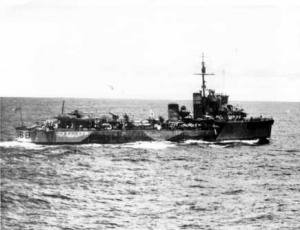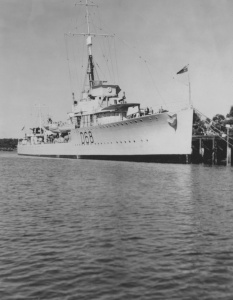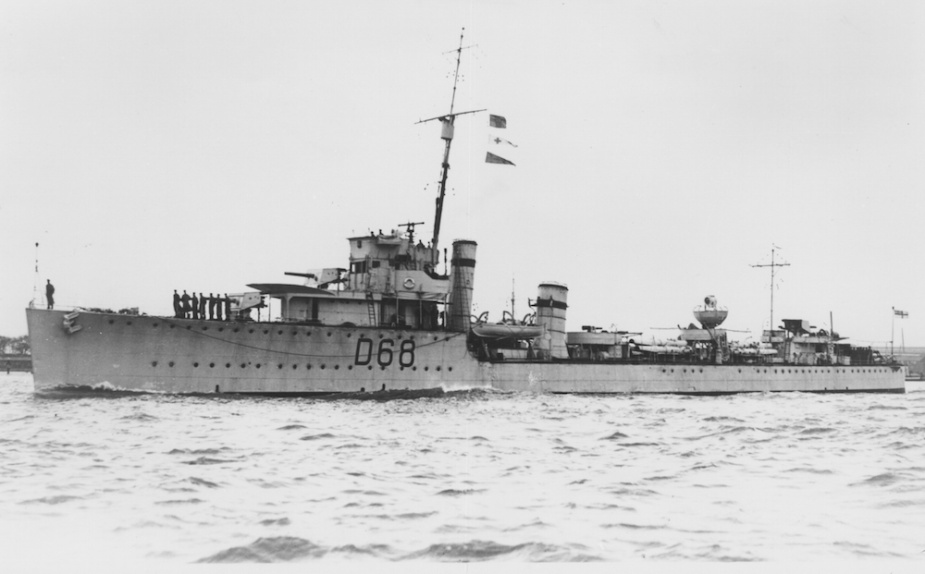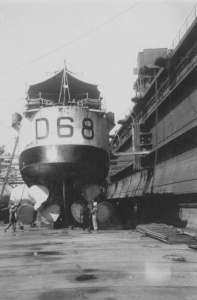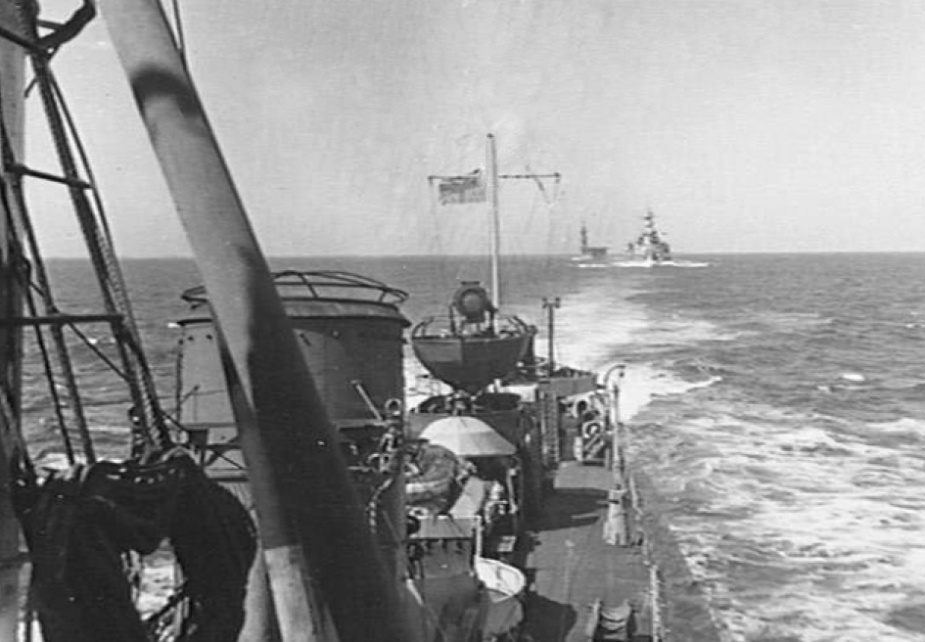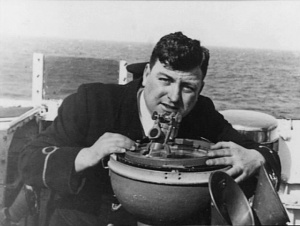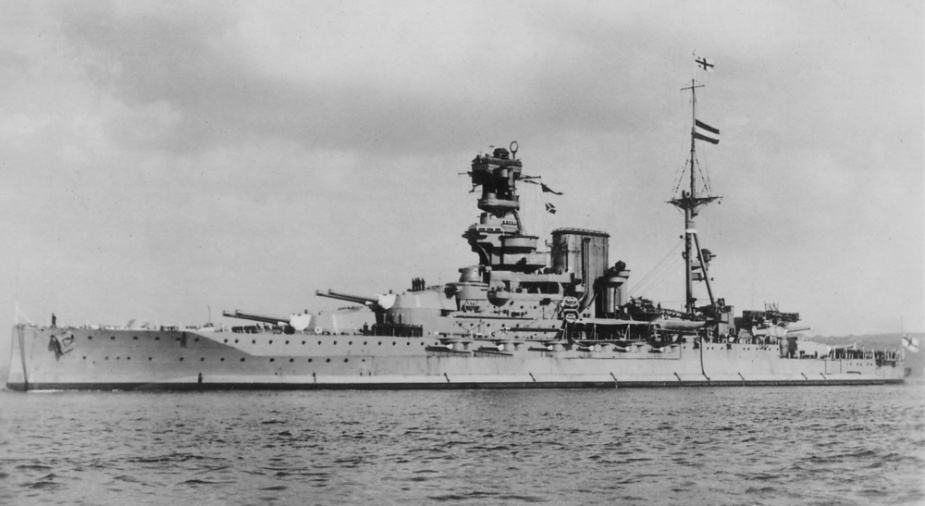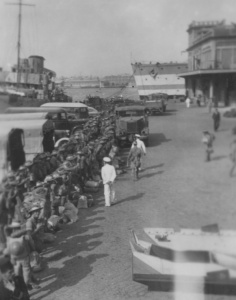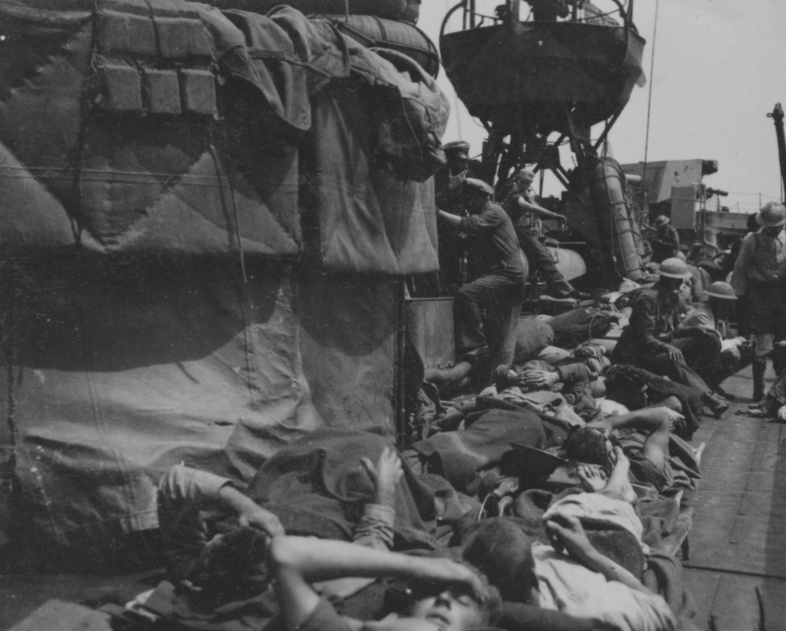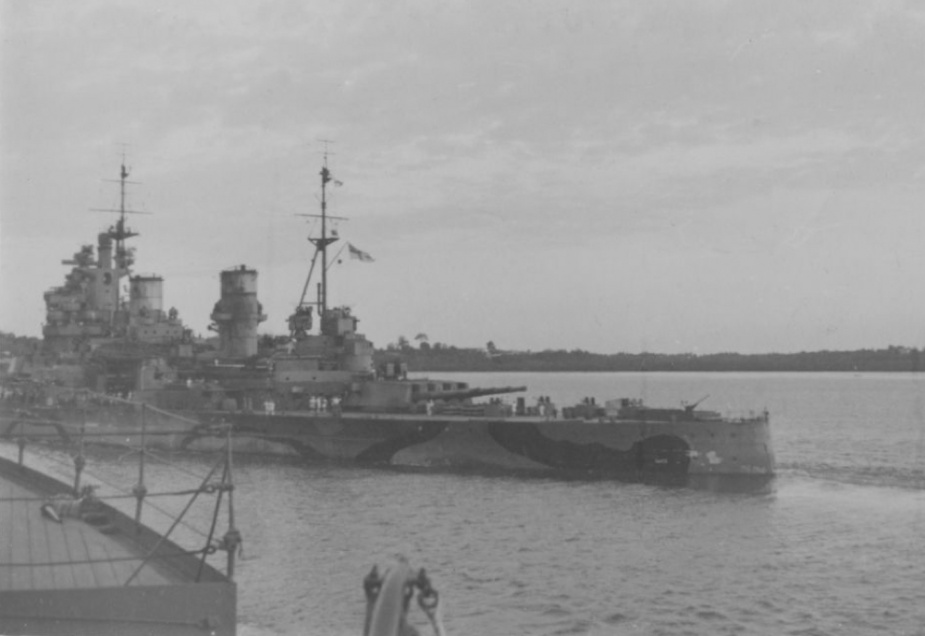HMAS Vampire (I)
| Class |
V and W Class |
|---|---|
| Type |
Destroyer |
| Pennant |
D68 |
| Builder |
J Samuel White & Co Ltd, Cowes, England |
| Laid Down |
10 October 1916 |
| Launched |
21 May 1917 |
| Commissioned |
11 October 1933 |
| Fate |
Lost in action on 9 April 1942 |
| Dimensions & Displacement | |
| Displacement |
|
| Length | 312 feet 1 inch |
| Beam | 29 feet 7 inches |
| Draught | 9 feet 8 inches |
| Performance | |
| Speed | 34 knots |
| Complement | |
| Crew | 130 |
| Propulsion | |
| Machinery | Brown-Curtis turbines, twin screws |
| Horsepower | 27,000 |
| Armament | |
| Guns |
|
| Torpedoes | 6 x 21-inch torpedo tubes (triple mount) |
| Other Armament | 50 depth charges |
| Awards | |
| Battle Honours | |
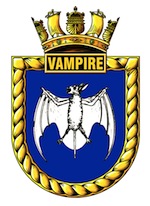
In 1933 the Admiralty agreed to loan the Flotilla Leader Stuart (I) and four V and W Class destroyers Vampire (I), Vendetta (I), Voyager (I) and Waterhen (I) to the Royal Australian Navy as replacements for the S Class destroyers Stalwart, Success, Swordsman, Tasmania and Tattoo and the Flotilla Leader Anzac, then due for scrapping. Vampire and the other four ships commissioned in the Royal Australian Navy at Portsmouth on 11 October 1933 to form the Australian Destroyer Flotilla, later to become famous as the ‘Scrap Iron Flotilla’ during World War II. Vampire was commissioned under the command of Commander Harry Howden RAN.
The Flotilla departed Chatham, under the command of Captain Austen Lilley RN (in Stuart), on 17 October 1933 and, proceeding via Suez, reached Singapore on 28 November. The next stop was Darwin, on 7 December, and Sydney was reached on 21 December 1933. On 31 January 1934 Vampire was paid off into Reserve.
Vampire recommissioned at Sydney on 14 July 1936 for the voyage to Westernport where she arrived on 17 July to replace Tattoo as a tender to HMAS Cerberus (Flinders Naval Depot). She paid off the following day into C Class Reserve and remained based at Westernport until 11 May 1938 when she recommissioned under the command of Lieutenant Commander Jack Donovan RAN. On 12 November 1938 Donovan handed over command of the destroyer to Lieutenant Commander John Walsh, RAN. Thereafter, until the outbreak of World War II, in September 1939, Vampire operated as a unit of the Australian Squadron in home waters.
On 14 October 1939 Stuart (I), Vendetta (I) and Waterhen (I) departed Sydney for Singapore, proceeding via Darwin and Lombok Strait. The same day Vampire and Voyager (I) departed Fremantle to join company at Singapore. The Flotilla was under the command of Commander Hector Waller RAN, in Stuart (I).
It had been intended to base the destroyers at Singapore for a period of training but, while the Flotilla was still at sea, it was decided that after a brief stop at Singapore it should proceed to the Mediterranean. Vampire and Voyager (I) arrived at Singapore on 21 October 1939 where they were joined on 29 October by Stuart (I), Waterhen (I) and Vendetta (I).
The Flotilla sailed from Singapore on 13 November 1939 but split up en route and consequently the ships did not all reach Malta at the same time. Vampire arrived on 24 December 1939. From 2 January 1940 the Flotilla formed the 19th Destroyer Division for service with the Mediterranean Fleet.
At this period of the war, British and French naval supremacy in the Mediterranean called for only routine escort and patrol duties, interspersed with fleet exercises. Nevertheless, the Australian destroyers were kept busy with their routine of escort and patrol work, singly and in pairs, which took them from one end of the Mediterranean to the other.
Vampire began her Mediterranean war service on 21 December 1939 when, in company with Voyager (I), she departed Port Said escorting a convoy for Malta. Thereafter until 6 March 1940 she was engaged in escorting convoys between Marseilles and Malta. Conditions during the early part of this period proved very trying for her crew newly arrived from Australia and the heat of the tropics. On 23 January at Marseilles, the temperature fell to 11 degrees Fahrenheit and the ship's sides became coated with two or three inches of ice.
On 14 February at Marseilles the ship was inspected by His Royal Highness Prince Henry, Duke of Gloucester. On 4 March 1940 Vampire began a 30 day refit at Malta. At this stage she had steamed 42,000 miles since her last refit and 26,000 miles since the commencement of hostilities. The refit was completed on 5 April 1940.
Vampire resumed her Malta to Marseilles escort duty until 22 April when she returned to Malta in company with Voyager (I). On 27 April she sailed in company with Stuart (I) for Gibraltar but both ships were recalled at 'best possible speed', for Vampire then 28 knots. On 29 April she sailed escorting the Mediterranean Battle Fleet for Alexandria.
Throughout most of May 1940 Vampire was based at Alexandria exercising with fleet units and on anti-submarine patrol duties. On 20 May she sailed as part of the escort for units of the French fleet en route to Bizerta. She returned to Alexandria, from Malta, on 26 May 1940. The following day, 27 May, the 19th Destroyer Division (Stuart (I), Vampire, Voyager (I), Vendetta (I) and Waterhen (I)) and the 20th Destroyer Division (HM Ships Dainty, Diamond, Decoy and Defender) combined to form the 10th Destroyer Flotilla under the command of Commander Hec Waller.
On 10 June 1940 Italy entered the war, on the Axis side, and operations against Italian forces soon commenced. Vampire spent June 1940 based at Alexandria for Mediterranean anti-submarine patrols and fleet exercises. She twice attacked submarine contacts without results, firstly on 13 June in company with Waterhen (I) and again on 17 June. On 26 June convoy escort duty was resumed. On 29 June Vampire experienced her first bombing attack when Italian aircraft dropped several bombs from high levels; with all missing their target.
The entry of Italy into the war and the collapse of French resistance on the 22 June completely changed the naval situation in the Mediterranean. Formerly, all coastlines were either Allied or neutral, and the Anglo-French fleets were in undisputed command of the seas. Now all coasts except those of Egypt, Palestine and Cyprus in the east, Malta in the centre, and Gibraltar in the west were closed to the Royal Navy. Moreover, the Allies had lost the support of the French fleet, which had provided seven capital ships and nineteen cruisers, and had acquired a new enemy in Italy with her menacing naval potential. Her fleet boasted five battleships, 25 cruisers, 90 destroyers and nearly 100 submarines. It spelt the beginning of a long and bitter struggle for control of the Mediterranean, first against the Italian fleet and Air Force (neither of which proved the menace expected) and later against the much more formidable German Luftwaffe whose dive bombers inflicted heavy losses before they were finally driven from the skies. For more than a year the ‘Scrap Iron Flotilla’ would take part in the struggle for possession of the ancient sea route linking east and west.
July 1940 opened with Vampire escorting a convoy to Port Said and then the French transport Providence to Alexandria. At Alexandria Vampire joined the Mediterranean Fleet for operations covering the passage of convoys between Malta and Alexandria and attacks against the coast of Sicily (Operation MA5). These operations, which led to the Battle of Calabria, on 9 July 1940, began on 7 July when the fleet sailed from Alexandria, Vampire and Voyager (I) forming part of the screen for the battleships and the aircraft carrier HMS Eagle, while the Flotilla Leader Stuart operated with screening units for the 7th Cruiser Squadron. The following day, 8 July, the fleet was heavily attacked from the air and Vampire began to learn the value of violent evasive tactics. In spite of the Italian effort - some 50 bombs fell near the battleship HMS Warspite, only the cruiser HMS Gloucester was hit.
At 6:00am on 9 July the British fleet was concentrated 50 miles due west of the south west extremity of Greece. The 7th Cruiser Squadron with Stuart in the van led the fleet eight miles ahead of Admiral Cunningham’s flagship, Warspite, and her screen. The 1st Battle Squadron (HM Ships Royal Sovereign and Malaya) and Eagle and their screening destroyers, including Vampire brought up the rear. Throughout the morning British reconnaissance aircraft reported strong Italian forces including two battleships at sea. Cunningham disposed the fleet accordingly in an attempt to force the enemy into action.
At 2:45pm HMAS Sydney (II), operating as a unit of the 7th Cruiser Squadron, sighted smoke on the port bow. Sixteen minutes later she sighted five enemy ships and seven minutes after that at 3:08pm, for the first time since the Napoleonic Wars, the sighting of an enemy battle fleet in the Mediterranean was signaled when the cruiser HMS Neptune reported two Italian battleships west south west, 15 miles distant. At this stage Vampire was engaged in screening the carrier Eagle acting independently and accompanied by the cruiser Gloucester that had been withdrawn as unfit for action due to the bomb damage suffered the previous day.
The engagement began at 3:20pm and went through several phases, beginning with a brief gunnery duel between the heavy surface units which ended at 4:00pm when the Italian fleet retired under cover of smoke and ending at 6:30pm when Admiral Cunningham finally broke off the chase of the fleeing Italian ships when some 25 miles off the Calabrian coast. No British ship suffered any damage or casualties but the Italian battleship Giulio Cesare was hit by Warspite's 15-inch fire and limped into port with six of her boilers out of action and 29 of her crew killed. After sunset Vampire detached from her task of screening Eagle and rejoined the battle fleet. For five hours, from 3:00pm onwards, the carrier and her two escorting destroyers had been under enemy air attack.
Vampire spent in all six days at sea during the progress of Operation MA5, screening the fleet and covering the passage of the convoys. Her War Diary recorded that she was under repeated air attack during daylight hours and estimated that 1350 bombs were dropped on ships of the fleet being screened by Vampire and on Vampire herself. Violent avoiding action prevented any direct hits but the ship suffered considerable damage from splinters and near misses. Warrant Officer (Gunner) - Torpedo John Endicott, RAN, died on 11 July as a result of bomb splinter wounds. He was the first battle death in a Royal Australian Navy ship during World War II.
Following bomb damage repairs at Alexandria, Vampire sailed on 23 July in company with Vendetta (I), screening the cruiser HMS Orion for a diversionary demonstration off Castelorizo Island. The ships were not sighted from the air and no response came from the defence's ashore. The two destroyers reached Port Said on 25 July and sailed the following day escorting the armed boarding vessels HM Ships Chakla and Fiona for a second demonstration. They met Orion on 27 July and that evening proceeded to simulate a landing on Castelorizo. Again the Italians refused to be provoked.
At sea, meanwhile, the fleet covered convoys moving across the Aegean Sea, seeking to provoke the enemy into attacking; but without response. On 29 July Vampire was back in Alexandria where a refit kept her in dock until 18 August, before resuming convoy escort duties between Alexandria, Port Said and Haifa, returning to Alexandria on 24 August.
On 29 August reinforcements for the Mediterranean Fleet arrived at Gibraltar. They comprised the battleship HMS Valiant, the new aircraft carrier HMS Illustrious and the cruisers HM Ships Calcutta and Coventry, named as Force F. To pass these additions to the fleet from west to east, a large scale activity (Operation HATS), was prepared which planned for cover as far as Sardinia by forces based at Gibraltar followed by linking up with the Mediterranean Fleet south of Sicily.
On 30 August the fleet, including Vampire, sailed from Alexandria to join Force F and to cover the passage of convoys to and from Malta. The operation, which ended on 4 September with the return of the fleet to Alexandria, suffered no surface interference though the Italian battle fleet was sighted by aircraft from Eagle. In the air the enemy reaction was mainly confined to attacks on one of the convoys but only one ship was hit. Vampire recorded that for the first time, on 2 September, she experienced dive bomber attacks while screening Eagle.
On 10 September, following a period of exercises with Illustrious, Vampire resumed convoy escort duty to Port Said and Haifa. On 14 September she passed through the Suez Canal to Port Tewfik where she remained until 23 September before proceeding to Alexandria. On 26 September Captain Waller joined the ship as Captain (D) 10th Flotilla.
October opened with Vampire at Alexandria preparing to join the battle fleet at sea on 3 October for Operation BMQ, a fleet sweep into the north west Mediterranean. The operation proved uneventful except for attacks by Vampire on a confirmed submarine contact on 4 October; but without result. The fleet returned to Alexandria on 6 October, sailing again two days later, with Vampire in company, to cover the passage of convoys to and from Malta. Vampire reached Malta on 11 October, fuelled and rejoined the fleet.
This period, which ended for Vampire on 15 October when she returned to Alexandria with the 2nd Division of the battle fleet, was marked by the usual air attacks and Vampire's new anti-aircraft gun was well utilised. It was also the occasion of the first surface engagement since the Battle of Cape Spada in July 1940, when the cruiser HMS Ajax engaged and destroyed the Italian destroyers Airone, Ariel and Artigliere on 12 October. Following the action Vampire recovered one officer and twenty one ratings from Artigliere.

